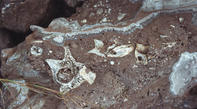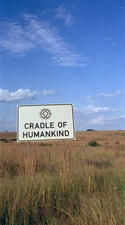A World Heritage Site
The Cradle of Humankind (or COH, as I familiarly call it) was first inducted onto the World Heritage List as a site of cultural significance in 1999, or site number 915 to you.

Initially, it incorporated about 20 caves within an area measuring 47 000 hectares (plus an additional 80 000 hectares of additional land which acts as a buffer-zone against predatory development). The site is focussed around the caves of Sterkfontein, Kromdraai and Swartkrans, situated about 45 kilometres north-west of Johannesburg.
Unusually for a World Heritage Site, most of the land in the Cradle is still in private hands, but the Sterkfontein Caves themselves are owned by the University of the Witwatersrand, after the land was donated to them by the farm’s original owners.
Now, many Gautengers may be familiar with the Sterkfontein Caves through dreary school outings to the rather decrepit visitor's centre at the caves, and thus will find it surprising that the Cradle has elicited such a strong response from the usually stoic UNESCO committee. However, there is much to be excited about.
Why the Excitement?

As the expert committee from ICOMOS (yet another acronym, this one stands for the International Council of Monuments and Sites) found in their evaluation: “This group of sites is one of the most important in the world for an understanding of the evolution of modern man (Homo sapiens sapiens) from his ancestors.
They have produced a wealth of hominid fossils, the oldest dated to some 3.5 million years ago, along with their tools and with fossils of the contemporary fauna. Investigations over the past sixty years have played a crucial role in establishing Africa as the cradle of mankind.
The potential for further significant discoveries is enormous.” All of this was enough to meet two of the ten criteria for World Heritage Status: To bear a unique or at least exceptional testimony to a cultural tradition or to a civilization which is living or which has disappeared. To be an outstanding example of a type of building, architectural or technological ensemble or landscape which illustrates (a) significant stage(s) in human history.
Thanks to the Cradle’s inscription on the UNESCO list, the area is now going through something of a rebirth. The humble visitor's centre at the Sterkfontein Caves has been significantly upgraded and now boasts a good restaurant, excellent museum and improved tours through the caves themselves. The authorities have also spent around R300 million building a state-of-the-art visitors centre, called Maropeng, a short distance away from the caves.
This is a very worthwhile attraction, where time travellers can find out more about evolution while enjoying lovely views over the Cradle. But the really exciting thing about the Cradle is that it is still very much a working site, and many ancient secrets are lying buried beneath the ground just waiting to be discovered.
Literally dozens of scientists, archaeologists and palaeoanthropologists are constantly excavating in the area, uncovering rare and mysterious fossils (both hominid and mammalian) that add to our incomplete understanding of the origins of life on Earth.
The Cradle Extended

In 2005, the appellation ‘Cradle of Humankind’ was extended to include two additional locations that were connected to the Sterkfontein area but not geographically contiguous with the original site.
These sites are the Taung quarry, near Kimberley, and Makapansgat, near Pietersburg/Polokwane. Both of these sites consist of the same kind of rock deposits as Sterkfontein (classified as part of the Transvaal Supergroup), and both contain valuable fossil specimens which confirm that hominids have lived in the area for an unbroken stretch of nearly 3 and half million years, if not longer. Perhaps the best thing about being the Cradle of Humankind being declared a World Heritage Site is that it has forced the authorities to draw up carefully considered and workable management plans that will ensure the area is run according to sustainable and socially-conscious principles.
For example, policies have been drawn up that will protect the natural beauty of the area while allowing for responsible development. A community participation scheme is being developed to create jobs and housing, so that local people get direct benefits from the influx of tourism. And partnerships with government and business are being pursued to ensure that the Cradle is able to remain financially viable.
All of this is good news, and could act as a case-study for other South Africa tourism initiatives in the future. After all, tourism walks a very fine line between preservation and desecration and, if things are not handled responsibly, there is the danger that we will destroy the very qualities that people are coming to see.